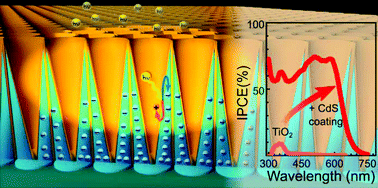A 1D conical nanotubular TiO2/CdS heterostructure with superior photon-to-electron conversion†
Abstract
Herein, a new strategy to efficiently harvest photons in solar cells is presented. A solar cell heterostructure is put forward, based on a 1D conical TiO2 nanotubular scaffold of high aspect ratio, homogenously coated with a thin few nm layer of CdS light absorber using atomic layer deposition (ALD). For the first time, a large variety of conical nanotube layers with a huge span of aspect ratios was utilized and ALD was used for the preparation of a uniform CdS coating within the entire high surface area of the TiO2 nanotubes. The resulting 1D conical CdS/TiO2 tubular heterostructure acts as a sink for photons. Due to the multiple light scattering and absorption events within this nanotubular sink, a large portion of photons (nearly 80%) is converted into electrons. It is the combination of the scaffold architecture and the light absorber present on the high surface area as a very thin layer, the optimized charge transport and multiple optical effects that make this heterostructure very promising for the next generation of highly performing solar cells.



 Please wait while we load your content...
Please wait while we load your content...